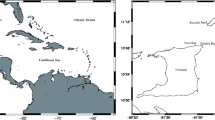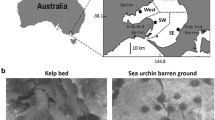Abstract
Migrating feeding aggregations (or fronts) of sea urchins can dramatically alter subtidal seascapes by destructively grazing macrophytes. While direct effects of urchin fronts on macrophytes (particularly kelps) are well documented, indirect effects on associated fauna are largely unknown. Secondary aggregations of predators and scavengers form around fronts of Strongylocentrotus droebachiensis in Nova Scotia. We recorded mean densities of the sea stars Asterias spp. (mainly A. rubens) and Henricia sanguinolenta of up to 11.6 and 1.7 individuals 0.25 m−2 along an urchin front over 1 year. For Asterias, mean density at the front was 7 and 15 times greater than in the kelp bed and adjacent barrens, respectively. There was strong concordance between locations of peak density of urchins and sea stars (Asterias r = 0.98; H. sanguinolenta r = 0.97) along transects across the kelp–barrens interface, indicating that sea star aggregations migrated along with the urchin front at rates of up to 2.5 m per month. Size–frequency distributions suggest that Asterias at the front were drawn from both the barrens (smaller individuals) and the kelp bed (larger individuals). These sea stars fed intensively on mussels on kelp holdfasts and in adjacent patches. Urchin grazing may precipitate aggregations of sea stars and other predators or scavengers by incidentally consuming or damaging mussels and other small invertebrates, and thereby releasing a strong odor cue. Consumption of protective holdfasts and turf algae by urchins could facilitate feeding by these consumers, which may obtain a substantial energy subsidy during destructive grazing events.







Similar content being viewed by others
References
Brady SM, Scheibling RE (2005) Repopulation of the shallow subtidal zone by green sea urchins (Strongylocentrotus droebachiensis) following mass mortality in Nova Scotia, Canada. J Mar Biol Assoc UK 85:1511–1517
Briscoe CS, Sebens KP (1988) Omnivory in Strongylocentrotus droebachiensis (Müller) (Echinodermata: Echinoidea): predation on subtidal mussels. J Exp Mar Biol Ecol 115:1–24
Clark AM, Downey ME (1992) Starfishes of the Atlantic. Chapman & Hall, London
Dare PJ (1982) Notes on the swarming behaviour and population density of Asterias rubens L. (Echinodermata: Asteroidea) feeding on the mussel, Mytilus edulis L. J Cons Int Explor Mer 40:112–118
Drolet D, Himmelman JH (2004) Role of current and prey odour in the displacement behaviour of the sea star Asterias vulgaris. Can J Zool 82:1547–1553
Gagnon P, Wagner G, Himmelman JH (2003) Use of a wave tank to study the effects of water motion and algal movement on the displacement of the sea star Asterias vulgaris towards its prey. Mar Ecol Prog Ser 258:125–132
Gagnon P, Himmelman JH, Johnson LE (2004) Temporal variation in community interfaces: kelp-bed boundary dynamics adjacent to persistent urchin barrens. Mar Biol 144:1191–1203
Gaymer CF, Himmelman JH, Johnson LE (2001a) Use of prey resources by the seastars Leptasterias polaris and Asterias vulgaris: a comparison between field observations and laboratory experiments. J Exp Mar Biol Ecol 262:13–30
Gaymer CF, Himmelman JH, Johnson LE (2001b) Distribution and feeding ecology of the sea stars Leptasterias polaris and Asterias vulgaris in the northern Gulf of St. Lawrence, eastern Canada. J Mar Biol Assoc UK 81:827–843
Gaymer CF, Himmelman JH (2002) Mussel beds in deeper water provide an unusual situation for competitive interactions between the seastars Leptasterias polaris and Asterias vulgaris. J Exp Mar Biol Ecol 277:13–24
Gaymer CF, Himmelman JH, Johnson LE (2002) Effect of intra- and interspecific interactions on the feeding behavior of two subtidal sea stars. Mar Ecol Prog Ser 232:149–162
Gosner KL (1978) A field guide to the Atlantic seashore from the Bay of Fundy to Cape Hatteras. Houghton Mifflin, New York
Hagen NT (1995) Recurrent destructive grazing of successionally immature kelp forests by green sea urchins in Vestfjorden, northern Norway. Mar Ecol Prog Ser 123:95–106
Harper FM (2004) Sperm, spines, secondary contact and cytoplasmic introgression between sibling species of sea stars. Ph.D. dissertation, Dalhousie University
Harris LG, Tyrrell M, Chester CM (1998) Changing patterns for two sea stars in the Gulf of Maine, 1976–1996. In: Mooi R, Telford M (eds) Echinoderms: San Francisco. A.A. Balkema, Rotterdam, pp. 243–248
Himmelman JH, Cardinal A, Bourget E (1983) Community development following removal of urchins, Strongylocentrotus droebachiensis, from the rocky subtidal zone of the St. Lawrence Estuary, Eastern Canada. Oecologia 59:27–39
Hjörleifsson E, Kaasa Ö, Gunnarsson K (1995) Grazing of kelp by green sea urchin in Eyjafjördur, north Iceland. In: Skjoldal HR, Hopkins C, Erikstad KE, Leinaas HP (eds) Ecology of fjords and coastal waters. Elsevier, Amsterdam, pp 593–597
Jangoux M (1982) Food and feeding mechanisms: Asteroidea. In: Jangoux M, Lawrence JM (eds) Echinoderm nutrition. A.A. Balkema, Rotterdam, pp 117–160
Lauzon-Guay J-S, Scheibling RE (2007) Behaviour of sea urchin (Strongylocentrotus droebachiensis) grazing fronts: food-mediated aggregation and density-dependent facilitation. Mar Ecol Prog Ser (in press)
Lawrence JM (1975) On the relationship between marine plants and sea urchins. Oceanogr Mar Biol 13:213–286
Lawrence JM, Sammarco PW (1982) Effects of feeding on the environment: Echinoidea. In: Jangoux M, Lawrence JM (eds) Echinoderm nutrition. A.A. Balkema, Rotterdam, pp. 499–519
Meidel SK, Scheibling RE (1999) Effects of food type and ration on reproductive maturation and growth of the sea urchin Strongylocentrotus droebachiensis. Mar Biol 134:155–166
Menge BA (1982) Effects of feeding on the environment: Asteroidea. In: Jangoux M, Lawrence JM (eds) Echinoderm nutrition. A.A. Balkema, Rotterdam, pp. 521–551
Moore PA, Lepper DME (1997) Role of chemical signals in the orientation behavior of the sea star Asterias forbesi. Bio Bull 192:410–417
Morissette A, Himmelman JH (2000) Subtidal food thieves: interactions of four invertebrate kleptoparasites with the sea star Leptasterias polaris. Anim Behav 60:531–543
Parrish JK, Edelstein-Keshet L (1999) Complexity, pattern, and evolutionary trade-offs in animal aggregation. Science 284:99–101
Pedersen E, Hunt HL, Scheibling RE (2000) Temporal genetic heterogeneity within a developing mussel (Mytilus trossulus, M. edulis) assemblage: the effects of species-specific settlement patterns and post settlement selection. J Mar Biol Assoc UK 80:843–854
Scheibling RE (1980) Dynamics and feeding activity of high density aggregations of Oreaster reticulatus (L.) (Echinodermata: Asteroidea) in a sand patch habitat. Mar Ecol Prog Ser 2:321–327
Scheibling RE, Hennigar AW, Balch T (1999) Destructive grazing, epiphytism, and disease: the dynamics of sea urchin–kelp interactions in Nova Scotia. Can J Fish Aquat Sci 56:2300–2314
Scheibling RE, Hatcher BG (2001) The ecology of Strongylocentrotus droebachiensis. In: Lawrence JM (ed) Edible sea urchins: biology and ecology. Elsevier, Amsterdam, pp 271–306
Sheild CJ, Witman JD (1993) The impact of Henricia sanguinolenta (Muller, O.F.) (Echinodermata, Asteroidea) predation on the finger sponges, Isodictya spp. J Exp Mar Biol Ecol 166:107–133
Silliman BR, van de Koppel J, Bertness MD, Stanton LE, Mendelssohn IA (2005) Drought, snails, and large-scale die-off of southern US salt marshes. Science 310:1803–1806
Sivertsen K (1997) Geographic and environmental factors affecting the distribution of kelp beds and barren grounds and changes in biota associated with kelp reduction at sites along the Norwegian coast. Can J Fish Aquat Sci 54:2872–2887
Sloan NA (1980) Aspects of the feeding biology of asteroids. Oceanogr Mar Biol A Rev 18:57–124
Sloan NA, Campbell AC (1982) Perception of food. In: Jangoux M, Lawrence JM (eds) Echinoderm nutrition. A.A. Balkema, Rotterdam, pp 3–24
Stoner AW, Lally J (1994) High-density aggregation in queen conch Strombus Gigas: formation, patterns, and ecological significance. Mar Ecol Prog Ser 106:73–84
Witman JD, Genovese SJ, Bruno JF, McLaughlin JW, Pavlin BI (2003) Massive prey recruitment and the control of rocky subtidal communities on large spatial scales. Ecol Monogr 73:441–462
Acknowledgments
We thank J. Lindley, D. Lyons, M. Saunders, P. Gagnon, and A. Pinder for assistance with diving, and especially D. Knip for help processing samples and data in the laboratory. The research was funded by a Discovery Grant from the Natural Sciences and Engineering Research Council of Canada (NSERC) to RES. J-SL-G was supported by scholarships from Fonds Québécois de la Recherche sur la Nature et les Technologies and NSERC.
Author information
Authors and Affiliations
Corresponding author
Additional information
Communicated by R.J. Thompson, St. John's.
Rights and permissions
About this article
Cite this article
Scheibling, R.E., Lauzon-Guay, JS. Feeding aggregations of sea stars (Asterias spp. and Henricia sanguinolenta) associated with sea urchin (Strongylocentrotus droebachiensis) grazing fronts in Nova Scotia. Mar Biol 151, 1175–1183 (2007). https://doi.org/10.1007/s00227-006-0562-3
Received:
Accepted:
Published:
Issue Date:
DOI: https://doi.org/10.1007/s00227-006-0562-3




